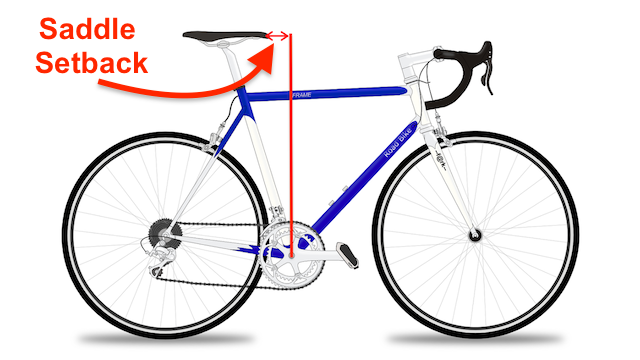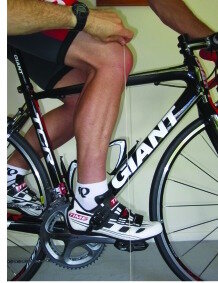Saddle fore/aft position, also called saddle setback, determines the position of your knee and hips in relation to your foot-pedal connection. Moving your saddle forward or backward changes the range of motion of your hips, knees, and ankles, which alters your pedal stroke.
The ideal saddle setback places you in a position that utilizes your quads and hamstrings evenly, which makes you more efficient and reduces injuries as no one group is over-worked.
Saddle Setback Definition & Measurement
- Saddle setback is measured in millimeters and is the horizontal distance from the front tip of the saddle to the bottom bracket (see figure-1 or the image above)
Saddle Fore/Aft & Handlebar Reach
- Using the fore/aft position to change the distance between your seat and handlebars (reach) is incorrect. A different length stem should be used to adjust your “reach” or possibly even a larger or smaller frame.
Signs your saddle is too far back
A saddle that is excessively too far back alters your hip angle which subsequently places more stress on your hamstrings and butt muscles during the pedal stroke.
Below is a list of possible signs that your saddle is too far back:
Pain in the back of both your knees (pain in one knee is a sign that your saddle is too high)
Feet go numb (from “toeing” the pedals)
Upper hamstring pain in both legs
Quads only feel like they are working on climbs as you sit more forward on the seat
Over-reaching
Handlebars feel like they are far away from you and you really have to reach for them
Pain from being overstretched, especially in your scapula
Fast cornering Issues
The majority of the weight will be in the back of the bike which makes high speed cornering difficult and dangerous
However, everyone has a unique body, so it’s possible that you won't experience any of these symptoms as these are general Rules of Thumb.
Finding optimal saddle setback: Kops & COG
Unlike saddle height, which has hundreds of studies and several “formulas,” saddle setback is under-researched with no magical measuring technique.
However, there are two schools of thought for finding the starting point for your fore/aft saddle position:
KOPS or Knee Over Pedal Spindle
COG or Center of Gravity (Balance Test)
Proponents of the Center of Gravity method will say that the KOPS method is outdated with no hard scientific data to support it. However, the COG technique has even less validated data and has been around since the 1980s, so it’s not as modern as many advocates contend.
Either way, both of these methods will provide you with a starting point to experiment with and get you into your ideal saddle setback range.
Knee over Pedal Spindle (KOPS)
KOPS METHOD
Image Source: International journal of sports physical therapy (2019)
The KOPS method or Knee Over Pedal Spindle does exactly what the name implies. Your saddle fore/aft position is set by placing your knee directly above the pedal spindle with the crank at the 3 o’clock position.
This will position your hip and knee joint over the drivetrain of the bicycle and allows you to push straight down on the pedal during the power phase of the pedal stroke.
This setting is considered the neutral position and is used as a starting point. From here, slight adjustments can be made in either direction, depending on your riding style and feel.
“If KOPS is to be used, I like the idea of simply using a straight edge, placing it in front of the kneecap and making sure this is in front of the pedal spindle. Used in this way KOPS has helped many riders get themselves into a safe setback position . ”
Balance Test Method
The Center of Gravity (COG) or Balance Test method was developed in the late-1980s but has come into fashion recently. This test looks to place the rider in a position slightly forward of their balancing point.
How to determine saddle fore/aft with the COG method:
Set optimal saddle height first
Pedal at a cadence you normally ride at in the drops
After you had a chance to warm-up and get into a groove - attempt to swing your arms back to your hips
Once you can maintain the same riding position with your hand behind your hips, with minimal alterations to your posture or cadence, then you set saddle fore/aft position.
If you can balance without tipping or shifting your weight then you are in the optimal position
Need helping reaching your goals?? Meet Performance Coach Jesse
saddle setback effects & science
The foremost experts on the effects of saddle setback are a group of researchers out of France. This research team, headed by Mathieu Ménard (PhD), in 2015, his team noted:
“Overall, Forward vs backward conditions have little influence on normal joint forces, but during the top transition phase (300-90°), shear forces in the Forward condition become especially high, more than twice those encountered during the Backward condition." (bolding is mine)
In a 2020 paper, Professor Ménard and his team then switched what was reported back in 2018:
"Our results indicate that moving the saddle forwards was not associated with an increase of patellofemoral joint forces. On the contrary, the tibiofemoral mean and peak compression force were 14 and 15% higher in the Backward than in the Forward condition, respectively." (bolding is mine)
Basically, if your saddle is too far forward or too far backward, issues will manifest. You don’t have one specific setting but instead a range. As long as you stay within this range you will optimize performance and reduce the chance of injuries.
Final Thought
If you think your saddle is too far backward or if you’re experiencing any of the signs, then it’s time to make adjustments to your saddle setback. However, it’s possible that your saddle fore/aft position is trying to make up for other incorrect settings, such as handlebar reach.
Yes please. Click me to learn how
Jesse is the Director of Pedal Chile and lives in La Patagonia. Jesse has a Master of Science in Health and Human Performance and a Bachelor of Science in Kinesiology. Hobbies: Mountain biking, bicycle commuting, reading, snowboarding, researching, and sampling yummy craft beers.
More articles from Pedal Chile
Sources & references for “Is My Saddle Too Far Back?”
Bini, Rodrigo Rico, et al. “Effects of Moving Forward or Backward on the Saddle on Knee Joint Forces during Cycling.” Physical Therapy in Sport, vol. 14, no. 1, Feb. 2013, pp. 23–27.
Burt, Phil. Bike Fit : Optimise Your Bike Position for High Performance and Injury Avoidance. London, Bloomsbury, 2014.
Cam Nicholls. “Is Your Saddle Too Far Forward OR Back? (HOW to Set Saddle Fore-Aft).” YouTube, 6 Oct. 2020, www.youtube.com/watch?v=ZX3fKolI25Q.
Domalain, M., Ménard, M., Decatoire, A., & Lacouture, P. (2016). Bike fitting: finding an optimum between performance and overuse injuries prevention? Influence of saddle fore-aft position on knee joint forces. Journal of Science and Cycling, 5(2).
Evens, Tim & Danoff, Jerome. (2019). Effects of Saddle Alignment and Pedal Stroke Training on a Competive Cyclist with Anterior Knee Pain. Online Journal of Health and Allied Sciences. 17.
Hayot, C., et al. “Muscle Force Strategies in Relation to Saddle Setback Management in Cycling.” Computer Methods in Biomechanics and Biomedical Engineering, vol. 16, no. sup1, July 2013, pp. 106–108.
Menard, Mathieu, et al. “Influence of Saddle Setback on Knee Joint Forces in Cycling.” Sports Biomechanics, 19 June 2018, pp. 1–13.
Ménard, Mathieu et al. “INFLUENCE OF CYCLIST SADDLE SETBACK ON KNEE JOINT FORCES.” (2015).
Menard M, Domalain M, Decatoire A, Lacouture P. Influence of saddle setback on knee joint forces in cycling. Sports Biomech. 2020 Apr;19(2):245-257.
stevehoggbikefitting. “SEAT SET BACK: For Road Bikes.” The Steve Hogg Bike Fitting Team, 14 May 2011, www.stevehoggbikefitting.com/bikefit/2011/05/seat-set-back-for-road-bikes/.
Petersen, Grant, and Retsu Takahashi. Just Ride : A Radically Practical Guide to Riding Your Bike. New York, Workman Pub, 2012.
Wadsworth, David J S, and Patrick Weinrauch. “THE ROLE of a BIKE FIT in CYCLISTS with HIP PAIN. A CLINICAL COMMENTARY.” International journal of sports physical therapy vol. 14,3 (2019): 468-486. doi:10.26603/ijspt20190468

















